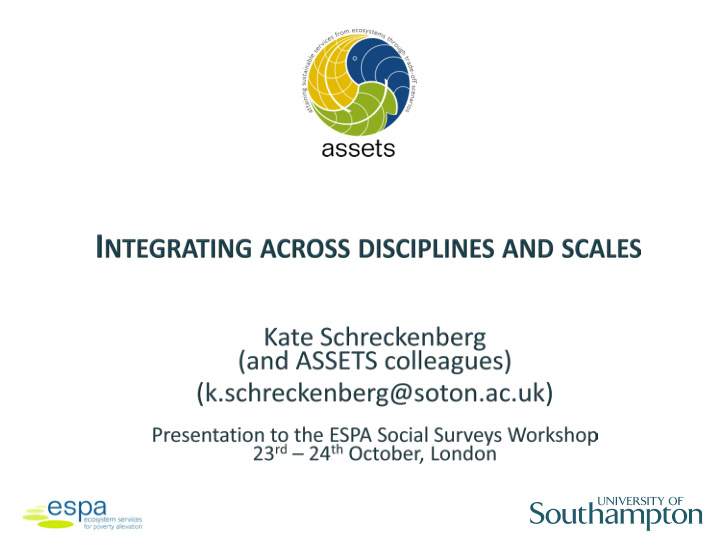



1
ESPA: • To provide new knowledge demonstrating how ecosystem services can reduce poverty and enhance well-being for the world’s poor ASSETS: • To quantify the linkages between ecosystem services that affect – and are affected by – food security and nutritional status for the rural poor at the forest-agricultural interface
Collecting different data at different scales Data types and methods Scenario workshops Socio-economic data (secondary) Biophysical data (secondary) PRA exercises Food diaries Household survey Individual Household Community Country
ABMs integrate HH survey and PRA data to model farmer decision- making • 3 types of HH, each with different decision-making patterns, helps account for heterogeneity within communities. Challenges: • Capturing system heterogeneity - scaling up beyond the community • Managing complexity • Developing ‘cognitive agents’ • Validation of ABMs • Presenting results • Integration with biophysical data
• Household survey of consumers (300) • Survey of transporters (200) • Survey of market sellers (50) • Rapid community surveys (45 villages) • RRA exercises and interviews in 3 communities • Key informant interviews • Observational studies (of markets and transporters) Harriet Smith
• We may not be able to engage with them formally or constructively, but cannot ignore them • Need to understand political ecology of social-ecological systems http://wwf.panda.org/about_our_earth/about_forests/de forestation/forest_illegal_logging/
• ‘Concept of fit’ (Young, 2002, in Herrfahrdt-Pähle, 2014) – better fit between social and ecological systems increases effectiveness of NR management – Spatial fit: matching resource boundaries and institutional regimes governing them – Functional fit: between ecosystems and resource use mechanisms – Dynamic fit: ability of institutions to keep pace with environmental change • Landscapes as the answer? • But scale is a social construct (Zulu, 2009) – Determined by politics and power
• Ultimately the need for ESPA-type projects arises because of natural resource governance failures • But ASSETS’ main research methods are not good at uncovering governance issues – HH surveys can capture membership and attendance but not active participation in decision-making – PRA can describe the theoretical state of affairs but rarely uncovers the real state of affairs • Possible additional methods: – Observation – Individual (anonymous) interviews – Ethnographic studies
• Integrating across scales and disciplines is essential • Requires a suite of mixed methods • Need to provide messages appropriate to the scale of our different target audiences • Don’t forget governance – both formal and informal
This presentation was as pr produ duced by by ASSETS ETS (N (NE-J00 002267 2267-1), funded wi with suppo pport fro from the he Ecos osys ystem Ser ervices es fo for Po Poverty Alle llevia iatio ion Prog ogramm mme (ES ESPA). The ES ESPA prog ogramm mme is is funded by by the he Depar artmen ent fo for International Dev evel elopmen ent (DF DFID) D), the Econ onomi mic an and So Social Resear earch Council (ESRC) RC) an and the Nat atural al Environment Res esea earch Council (NER ERC), as as pa part of of the UK UK’s Liv ivin ing wi with Environmental Chan ange Prog ogramm mme (LWEC). The view ews expres essed ed her ere ar are 12 tho hose of of the he aut uthors an and do do no not nec ecessar arily represen ent tho hose of of the he funders, s, the he ESPA Prog ogramm mme, the he ESPA Direc ectorate, e, or or LWEC EC.
References Herrfahrdt-Pähle, E. 2014. Applying the concept of fit to water governance • reforms in South Africa. Ecology and Society 19 (1):25. Zulu, L.C. 2009. Politics of scale and community-based forest management in • southern Malawi. Geoforum 40: 686-699. 13
Recommend
More recommend